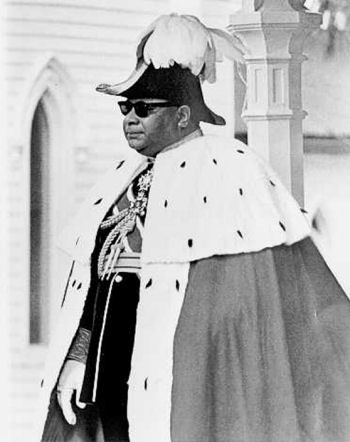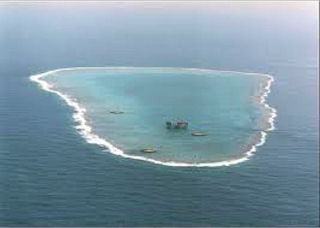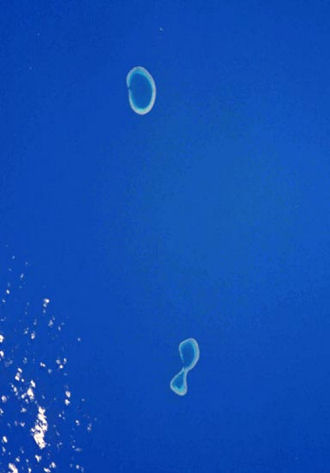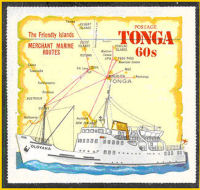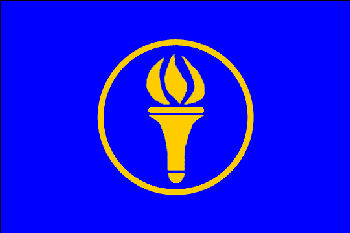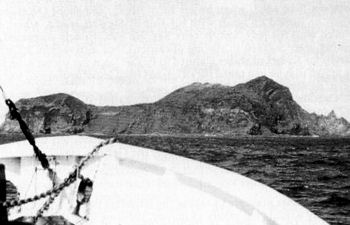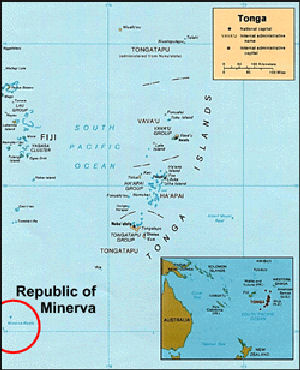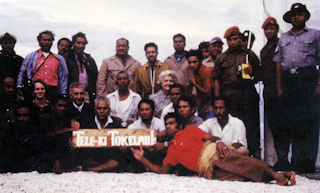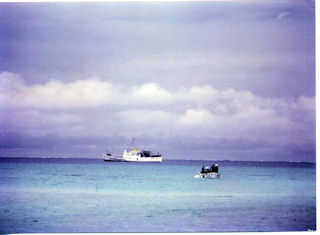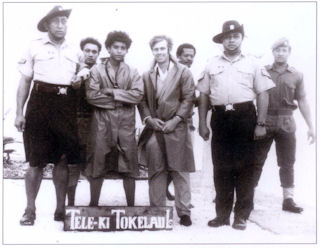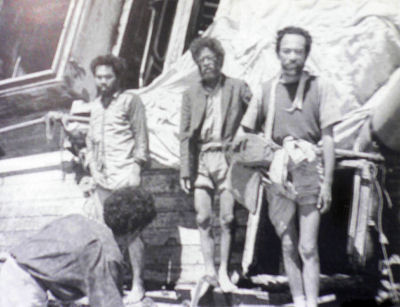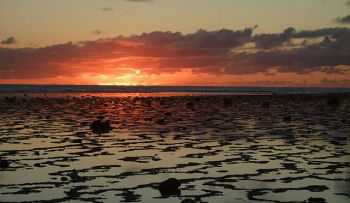A true record of the Minerva Reef saga of 1972 and the part played by the Tongan Shipping Company Vessel Olovaha |
I have read a number of accounts dealing with the dispute between the Kingdom of Tonga and the Republic of Minerva over their conflicting claims to the Minerva Reefs, and of the Tongan Governments subsequent occupation of, and claim to, the reefs. Much of this writing has been the product of the grossly over fertile imagination of authors who have never set foot within a thousand miles of Minerva. Here are some examples of this 'scholarship'.
'Private Islands Discussion Forum'.
"The Tongans never took too kindly to the micro-nation of Minerva. An army of angry, armed, plus-sized Tongans ready to push the settlers into the sea should be enough to scare anyone"
'Cabinet'. Issue 18 summer 2005
"On 21 June 1972, the worlds heaviest monarch, King Taufa'ahau Tupou IV of Tonga accompanied by members of the Tongan Defence Force, a convict work detail and a four piece brass band, set sail from his kingdom aboard the royal yacht Olovaha. On the king's stately mind was one thought, the invasion of the Republic of Minerva".
Out of such, are myths and legends born!
- Doug Jenkins, Bay of Islands, New Zealand -
What follows is my account of the so called 'invasion of Minerva'. It was 39 years ago, but memories of this unique experience are still very fresh. I was there. I sailed to Minerva with King Taufa'ahau and his retinue on board the Olovaha. The story was a big one throughout the Kingdom. On 15 June 1972 the 'Tonga Chronicle' published the full text of a Royal Proclamation. PROCLAMATION It was also announced that Taufa'ahau himself, would be sailing south to the reefs to formally claim title |
|||||||
His Majesty King Taufa'ahau Tupou IV |
|||||||
Prior to the proclamation, rumours had been growing for some time around Nuku'alofa of an international organization of dubious background proposing to create an artificial island on North Minerva by dredging the lagoon of South Minerva for the infill. As wild rumors began to give way to fact, it appeared that a syndicate known as the Ocean Life Research Foundation, conceived by Los Vegas real estate millionaire Michael Oliver, with considerable financial backing, and offices in London and New York, was behind the proposals to build this new micro-nation in the South West Pacific. Their stated object was to create a libertarian society, with no taxation, no welfare, no subsidies, or any form of state intervention. It would be supported by fishing, tourism, light industry and other commercial activities. The 'other activities' were never specified but no doubt would include banking and the registration of 'off shore companies'. It was envisaged by the group that the nearby Kingdom of Tonga would be happy to supply the labour for both the construction and future servicing of the new Republic of Minerva, to the mutual benefit of both states, (1) |
|||||||
Early in 1971 a visitor to Tonga, claiming the title of the Roving Ambassador for the Republic of Minerva, arrived in Nuku'alofa seeking an audience with the King in order to appraise him of the scheme. The audience was not granted. A senior member of the Prime Minister's Department however did meet with the 'Ambassador' and was shown a documentary film produced by the Pilkington Glass Company. The film was a feasibility study for a 'sea city' of 30,000 people that could be constructed on the Dogger Bank in the North Sea. This was the model upon which Michael Oliver's organization was basing its plans. International legal experts consulted by the Tongan Government had a different interpretation of the law pertaining to unclaimed lands. According to this interpretation land could not be claimed unless it was permanently above the high tide mark. The claimants could then lay claim not only to the said land but also to all adjacent reefs. As a result of this ruling an ocean going tug and barge, with a work party of prisoners from Tolitoli Prison was dispatched to the reefs. Within a relatively short time they had constructed from coral blocks and concrete two very small islands each resplendent with a flagpole. The islands of Teleki Tokolau and Teleli Tonga were born |
|||||||
At this point I would like to digress for a moment. In my title I make specific mention of the Tonga Shipping Company's vessel Olovaha. This for good reason. While surfing the net for background on Olovaha I came across an excellent web site, 'MV Queen of the Isles'. With contributions from ex-crew and passengers this covers the life of a much loved little ship, from her launching at Bristol England in 1964, as a ferry between Penzance and the Scilly Isles as 'Queen of the Isles', to Tonga as an inter Island ferry called 'Olovaha', to New Zealand as a floating casino called 'Gulf Explorer', to the tourist trade of Queensland once more as 'Queen of the Isles'. Renamed yet again 'Western Queen' for work in the Solomon Islands, she sadly ended her days blown ashore by cyclone Justin in 1997. The one flaw in this account is the sparseness of information on the ships years under the flag of Tonga and no mention at all, of the roll she played in the Minerva Reef saga. This I believe must have been one of the highlights of her 33 year career and deserves to be remembered. |
|||||||
Olovaha sailed from Nuku'alofa at 11.30 pm on a Saturday night. We had to leave before midnight as strict Sunday observance in the kingdom forbade vessels to depart or any work to be done on the Lords Day. On board, His Royal Majesty King Taufa'ahau Tupou IV, his nobles, his cabinet ministers, his royal fishermen, a platoon of solders, a police contingent, the full police brass band, Olovaha's officers and crew, a German doctor and his wife, an American lady journalist, myself and my young Tongan companion Suliano Etu. A truly crowded little ship! The royal entourage occupied the officers and masters quarters on the upper deck, the nobles, cabinet ministers and honorary nobles (all but one!) occupied the observation lounge below the bridge deck, police and military were accommodated in the cargo hold, the fishermen bunked in with the crew and Suliano and I camped on the after deck. On boarding I had been directed to the observation lounge and Suliano to the deck, I insisted on joining him. I preferred to be an 'honorary commoner'. Having been told to bring our own food, we carried a back pack containing two sleeping bags, a small primus stove, some tined food and some loaves of bread. We went aft, to make camp among the mooring bollards.(3) |
|||||||
I slept well that first night under a canopy of brilliant stars, lulled by the rhythmic beat of ships engines and the roll of an ocean swell. I awoke from a dream of heavenly music, as from a male voice choir, opened my eyes and there on the deck before me stood a pair of very large feet in shiny black sandals. From the feet, my eye panned upwards, two brown, muscular and very hairy legs, to a black vala and ta'avala. I looked to the left and to the right, I was surrounded by them. I had awoken in a forest of hairy legs, and what's more they were singing hymns. The owners of the legs that is. It was Sunday morning and church had convened on the largest open meeting place on board, 'my' after deck. Slowly, and I hope unobtrusively, I extracted my self from the sleeping bag, in which fortunately I was wearing shorts and shirt, and joined the congregation. Suliano slept on among the legs. When later I asked how he could manage to sleep through all that singing he confessed to only be pretending to sleep. He was Catholic he said, and had no intention of joining "that Methodist service" Later that morning land appeared. A small island, very high, caped with forest and cloud, and skirted by imposing and precipitous cliffs. The island of Ata, some 100 nautical miles south of Nuku'alofa. |
|||||||
Here Olovaha dropped anchor on the southern side, between the pinnacles and the island. Despite the fact that it was Sunday, when it is normally prohibited, the King gave permission for fishing to commence, on the condition that all catches were to go into the royal larder. Suddenly fishing lines appeared, it seemed with every one, from noble to common sea man, all had come prepared except for Suliano and my self. The fishing was exciting but not very profitable. Most of the catch being sharks, and most of the sharks lost while hauling them up the high ships sides. Just David returned the boys, first to Nuku'alofa and then to their home islands in Ha'apai. While in Tongan waters Warner was impressed by the fishing potential and as a result established a fishing and fish processing enterprise in Nuku'alofa. He named the first vessel built for this venture Ata, for the island from which the boys had been rescued. Shortly before we were about to leave Ata for Minerva that day, a vessel made its appearance from behind the island and moved to anchor alongside us. It was Peter Warner's long line fishing vessel Ata. |
|||||||
Seeing the Royal Standard flying from our mast, gifts were immediately hoisted aboard for His Majesty, three large tuna and three large turtles. These were laid side by side on the deck, three of the men from Ata sat cross legged on one side, while three nobles, representing the king sat facing them across the gifts. An elaborate formal presentation then took place. Ceremonial over the fishermen returned to their boat. Both vessels retrieved their anchors and proceeded on their respective journeys, Ata, north to Nuku'alofa with her catch and Olovaha south, toward the Minervas'. Late the following afternoon, out of what seemed an endless ocean, a line of broken water appeared on our horizon. We had reached North Minerva. Olovaha pitched and rolled heavily as we negotiated the narrow gap of rapidly shoaling water but within a few minutes every thing became still. We were in a comparative mill pond surrounded by a rolling ocean, a strange feeling. We made a turn to port, toward the deeper anchorage on the northern edge of the lagoon and there, before us lay Tel'eki Tokelau Island, much smaller than I had envisaged, surmounted by her flag pole. Near by lay the boilers and engine of one of the many wrecks that are scattered about the reef. Before sleep that night I lay wondering what the next day would bring, there were so many of us on this boat, and that Island looked so very small, there was no way that we could all fit ashore. Would Suliano and I even get the chance to land? After all we were among the least important of those on board. |
|||||||
Come morning and my concerns were answered. For the ceremony, the King would remain onboard (in fact he did not go ashore at all) along with the brass band. The soldiers, armed with 303 lee-enfields for firing the salute, also remained on the Olovaha. There was room for us. As this was an important royal occasion all were dressed in their best finery. Police and military in dress uniform, ministers of religion in their robes, nobles and cabinet ministers, and Suliano, in their best valas and ta'avalas. For the occasion even I had taken shoes and socks, long trousers and a tie. The ships life boats were swung out, we scrambled aboard, and set off. Then there came a problem. On reaching the edge of the coral it was discovered that Olovaha's boats drew to much water to be able to cross the reef, and we still had about 100 yards to go to reach our destination. It was over the side we all went in all our finery to wade ashore at times in chest deep water. What a sight we made on reaching the island. And so the ceremony began. A member of the defense force, with hand held radio, coordinated what was taking place on the island with the activities onboard Olovaha. Hymns were sung and prayers were prayed. The proclamation was read. Police and military stood stiffly to attention. A soldier knelt before a minister of the church with the neatly folded flag on his outstretched arms for it to be blessed. A bugle sounded, and to the strains of the national anthem coming across the water from the ship, the red and white ensign of Tonga was slowly hoisted. This was followed by the salute, fired from 'Olovaha's guns'. Throughout all of this we all stood, dripping wet in our finery. |
|||||||
My feelings that day were to say the least, an unusual mixture. Was I partaking in some strange farce, played out in the middle of the ocean? In many ways the whole scene was quite Gilbertian. We could well have been the rehearsing cast for HMS Pinafore or the Pirates of Penzance. There were times when I could have laughed at the weird performance in which I was participating, and yet, for much of the ceremony I was considerably moved. I was being involved in history. I was participating in a ceremonial the likes of which had probably not occurred since Cook raised the flag in New Zealand, claiming the land for His Majesty King George III. Here I was, with King Tafu'ahau IV, raising the flag over a new land. Such an occurrence may never happen again in the history of mankind. This may seem rather an extreme hyperbole, but in fact it was just how I felt. The following day Suliano and I left the ship and swam to the reef with fins and goggles, to explore the coral. After a time we noticed one of the ships boat's approaching. Ashore came the whole contingent of nobles and with them a large Kava bowl. We swam to within a short distance of the island, and being inappropriately dressed to go ashore sat with just our heads above water and watched. We were privileged to witness at first hand a full noble kava ceremony. Normally, a rare sight, but even more so in such an unusual setting. |
|||||||
Early the next morning anchor was weighed and we left for South Minerva. It was as well that the formal ceremonies had taken place on North Minerva as the weather now began to deteriorate. After negotiating the entrance to South Minerva, we crossed the lagoon to Tele'ke Tonga. Here the island had been constructed near the remains of the Japanese fishing boat that had provided shelter to the crew and passengers of the ill fated Tongan cutter Tuaikaepau in 1962. A number of Tuaikaepau's complement died and were buried on the reef so sadly adding a more emotive aspect to Tonga's claims. (5) Two days later Olovaha steamed into Nuku'alofa. One of the highlights of my four years in the Kingdom had come to an end. Over the years I have related this story many times. Listeners to my tale have often said that I should put it on paper, now, 39 years later, I have done just that. Some minor aspects of the occasion I have no doubt have been eroded by the mists of memory and time but basically this is a true account of what I remember of that event in Tongan history. I was there. |
|||||||
Finally, what has happened to those two lonely islands, Teleki Tokelau and Teleki Tonga? The sands of time have been cruel to them. No matter how robust the men from Tolitoli had constructed them, the relentless pressure of tidal current and stormy sea has returned them to the coral from which they were born. Yachts once avoided the Minerva, but today, with the safety of GPS many now visit. None however mention the existence of those two artificial islands that enabled Tonga to claim the reefs that were rightfully hers, the names of Teleki Tokelau and Teleki Tonga, it seems have just quietly slipped off the chart. (6) |
|||||||
Foot Notes
There is no doubt that the members of the Ocean Life research foundation were serious in their intentions to form a new republic, apart from their flag, they struck coinage, postage stamps and even issued certificates of competency in their name. |
|||||||
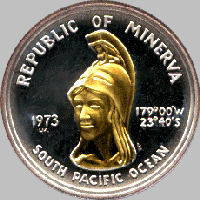 ... ...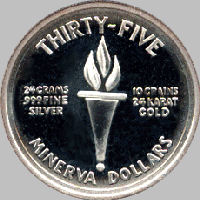 |
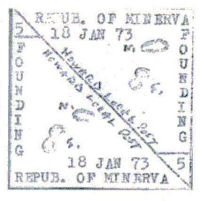 |
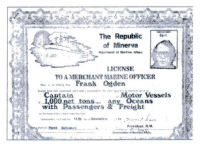 |
|||||
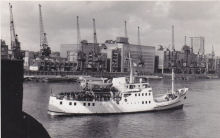 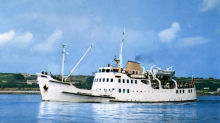 |
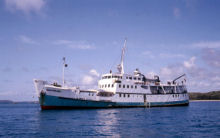 |
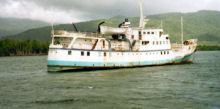 |
|||||
The vessel as Queen of the Isles I. This was her appearance while operating in Tongan waters. |
Olovaha as Queen of the Isles II after the refit. Note the extended boat deck, and narrower funnel. |
||||||
|
|||||||
